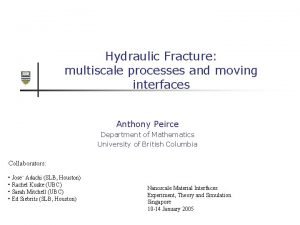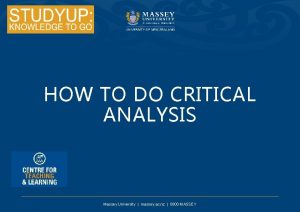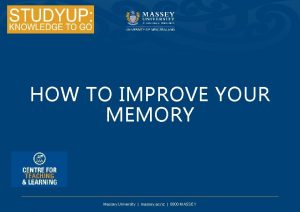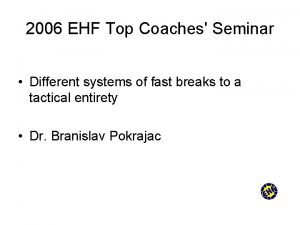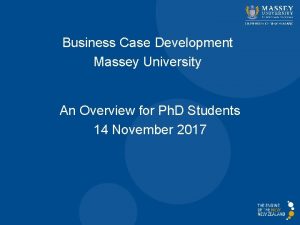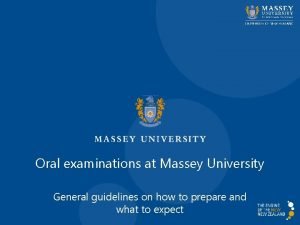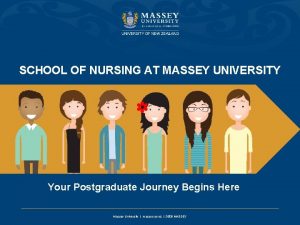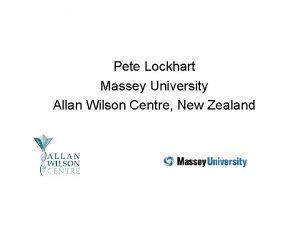Ergonomicshuman factors EHF at Massey University from 2017


























- Slides: 26

Ergonomics/human factors (EHF) at Massey University from 2017 Centre for Ergonomics, Occupational Health and Safety School of Public Health College of Health Contact: Professor Stephen Legg (S. J. Legg@massey. ac. nz)

Minor in Ergonomics/Human Factors (EHF) A ‘first’ in NZ A Minor in the Bachelor of Health Sciences Taught internally (Wellington - Semester 1) and by Distance Learning Four EHF Courses: 251. 100: Work and Health* 128. 200: Healthy Workplace Design* 128. 300: Ergonomics/Human Factors: work, performance, health and design Either 252. 201: Sleep/Circadian rhythms/Shiftwork or 251. 271: Occupational Health and Safety 1 * Note: 251. 100 Work and Health and 128. 200 Health Workplace Design are new courses

Postgraduate Diploma /Masters in Public Health with optional courses in Ergonomics/Human Factors (EHF) 180 Credits, including EHF optional courses: 128. 702: Work Capacity and Performance (15 credits) 128. 705: Ergonomics Analysis (30 credits) (not offered in 2017) 128. 706: Micro-Macro Ergonomics (30 credits) 128. 707: People, Technology and Design (15 credits) (not offered in 2017) Public Health Professional Practice course(s) in EHF courses cover educational and practice components required for professional certification as an international and an NZ Ergonomist

Postgraduate Diploma/Masters in Health Sciences with specialisation in Ergonomics/Human Factors (EHF) from 2018 180 Credits, including EHF courses: 128. 702: Work Capacity and Performance (15 credits) 128. 705: Ergonomics Analysis (30 credits) 128. 706: Micro-Macro Ergonomics (30 credits) 128. 707: People, Technology and Design (15 credits) A Hlth Sci Research Course in EHF Hlth Sci Professional Practice course(s) in EHF Specialisation covers educational and practice components required for professional certification as an international and an NZ Ergonomist

Ph. D in Ergonomics The most recent Ph. D: Baiduri Widanarko Interaction between physical and psychosocial risk factors for low back pain Current Ph. D scholar: Mark Lidegaard Realist analysis of the uptake, use and impact of the ACC New Zealand Guidelines for Moving and Handling People Ph. D with Massey/AUT – Stephven Kolose NZ Defence Force anthropometry survey Contact: Professor Stephen Legg (S. J. Legg@massey. ac. nz)

Content of Massey EHF Courses See following slides

Course 251. 100 Work and Health Taught internally (Wellington Semester 2) and by Distance learning Content Positive and negative aspects of work Good work OHS management in organisations Technology and work Societal regulation of workplace health and safety History and development of OHS legislation Work and health in praxis

Course 128. 200 Healthy Workplace Design Taught internally (Wellington Semester 1) and by Distance learning Option for students in many disciplines Can be taken by anyone as an ‘interest’ paper Content Ergonomics/human factors WHO Healthy workplaces Work, health and community Creating a healthy workplace Manual handling Preventing discomfort, pain and injury Computer workstation design Healthcare workplace design in praxis

Course 128. 300 Ergonomics/human factors (EHF): work, performance, health and design Taught Internally (Wellington) and by Distance learning over two semesters - with face-to-face contact course Option for students in many disciplines (e. g. nursing, sport, exercise, health, design, engineering) Core paper in the Grad Dip OHS or taken by anyone as an ‘interest’ paper Content Integrated ergonomics, Physical ergonomics, Ergonomics systems design, Environmental ergonomics, Cognitive ergonomics, Organisational ergonomics, Shiftwork/Sleep/Jetlag, Sports Ergonomics, Ergonomics in Design, Ergonomics field study in industry, Eco-ergonomics, Ergonomics in Praxis

Course 128. 702 Work Capacity and Performance Taught by Distance learning over two semesters Content Anatomy Biomechanics, Posture, Anthropometry Energy and force production, stress and strain Chronobiology, circadian rhythms, work-rest schedules Climatic environment, vibration Measurement equipment and methods Assessing job requirements and worker capabilities

Course 128. 705 Ergonomics Analysis Taught by Distance learning over two semesters Content Ergonomics approach Methods of measurement and investigation Instrumentation Work analysis Workplace design Information design Work organisation design Professional issues

Course 128. 706 Micro-macro Ergonomics Taught by Distance learning over two semesters Content Ergonomics principles Human psychological, social and organisational characteristics Systems theory, human reliability, training, instruction Health, safety, well-being Workplace, information and work organisation design Professional issues

Course 128. 707 People, Technology and Design Taught by Distance learning over two semesters Content User-centred principles and practices in design of products, equipment and complex systems People in relation to the physical environment, technology and design Design process, measurement, investigation methods, interface design Systems theory Training, Information design Workplace, Work organisation design Professional issues

Human Factors and Ergonomics at AUT Dr Fiona Trevelyan

AUT study pathways • Postgraduate Certificate in Health Science/Rehabilitation focusing on Moving and Handling • Graduate Certificate and Diploma in Business (Grad. Dip. Bus) programme focusing on Occupational Health, Safety and Wellbeing (OHSW)

PGCert Health Science focusing on Moving and Handling AIM of certificate: • Provides learning in key areas to support effective implementation of the MHP Guidelines (i. e. human factors/ergonomics, risk assessment, risk management) • Empowerment in the application of evidence based practice • Aligned with internationally recognised best practice

Postgraduate Certificate in Health Science specialising in Moving and Handling (60 points) Paper Title Points RHAB 811 Health Ergonomics 15 points RHAB 801 Occupational Ergonomics Concepts of Moving and Handling 30 points 789130 Special Topic Applied Paper 15 points • Vocational Rehabilitation and Management (RHAB 802)(30 points)

Health Ergonomics • Provides a broad based introduction to ergonomic principles and their application in the design of work, equipment and the workplace. • Explores and examines methodological approaches to ergonomics problem solving.

Content/topics: HErgs paper • Definition and scope of ergonomics and systems of work • Measurement of human characteristics, capabilities and limitations • Musculoskeletal disorders arising from manual handling and repetitive work • Risk assessment tools to evaluate physical and psychosocial factors within the work environment • Work design and task analysis

Occupational Ergonomics – Concepts of Moving and Handling • Promotes critical synthesis and the application of current evidence and theory to healthcare and industrial settings • Utilises a systematic approach to evaluate and reduce workplace risk associated with moving and handling

Content/topics: Concepts of M&H • Legal context of moving and handling • Assessment of risk associated with moving and handling • Design of the physical environment • Evaluation and management of complex moving and handling scenarios • Interventions to reduce risk associated with moving and handling

Special Topic Aim of paper To develop skills of independent, critical scholarship working with an area of personal interest related to M&H e. g. application of TROPHI audit tool within a ward/department (Fray and Hignett, 2012) Structure • Self-directed paper

Graduate Diploma and Certificate in Business focusing on Occupational Health, Safety and Wellbeing (from 2018) Graduate Certificate (4 papers) Points 1 Occupational Health, Safety & Wellbeing 15 2 Risk Management 15 3 Training and Development 15 4 Leadership for Change 15 Graduate Diploma (8 papers) Points 5 Health and Safety Law 15 6 Occupational Stress & Resilience 15 7 Employment Regulations and Dispute Resolution 15 8 Special Topic Applied Project 15

Human Factors & Ergonomics Society of NZ The scientific discipline. . . . understanding the interactions among people and other elements of a work system……to optimise human well-being, safety and overall system performance” (Horberry et al 2011) Includes professionals from all sorts of different background: • health, engineering, psychology, design, architecture, physiology, IT, management, sports science • Different membership types available

Health and Safety Association of NZ (HASANZ) • Purpose to raise professional standards across the health and safety sector • HFESNZ a founding member of HASANZ

Summary • AUT PG Certificate in Health Science aims to provide learning in key areas that underpin the M&H People Guidelines (ACC, 2012) • AUT Grad. Dip. Bus is an Occupational Health and Risk Management qualification which offers an opportunity to strengthen and broaden areas of expertise.
 Ehf
Ehf Ehf referees
Ehf referees Massey exam timetable
Massey exam timetable Massey machine shop
Massey machine shop Ib world school
Ib world school Joe massey castle and cooke
Joe massey castle and cooke St mark's church dunham massey
St mark's church dunham massey Barbara massey
Barbara massey Joseph massey mcx
Joseph massey mcx Situation vs site factors
Situation vs site factors Abiotic factors
Abiotic factors Abiotic factors and biotic factors
Abiotic factors and biotic factors Abiotic factors and biotic factors
Abiotic factors and biotic factors Biotic vs. abiotic factors infographic
Biotic vs. abiotic factors infographic Site vs situation factors
Site vs situation factors Common factors of 8 and 36
Common factors of 8 and 36 7-1 factors and greatest common factors
7-1 factors and greatest common factors Factors of 42
Factors of 42 詹景裕
詹景裕 Vcaa 2017 english exam
Vcaa 2017 english exam Xxxxxx mon
Xxxxxx mon Astro quiz 2017 questions and answers
Astro quiz 2017 questions and answers Saasta astro quiz 2017 round 2 questions and answers
Saasta astro quiz 2017 round 2 questions and answers Astro quiz 2019 questions and answers
Astro quiz 2019 questions and answers Forrester grc wave 2017
Forrester grc wave 2017 érzelmi szinkretizmus
érzelmi szinkretizmus Vs_wdexpress
Vs_wdexpress
